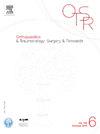Femoral trochlear groove cartilage damage after open-wedge high tibial osteotomy is associated with the change in patellar height relative to the femoral condyle
IF 2.3
3区 医学
Q2 ORTHOPEDICS
引用次数: 0
Abstract
Background
Medial open-wedge high tibial osteotomy (OWHTO) is performed for isolated medial compartment osteoarthritis or osteonecrosis of the knee and correction of varus deformity of the full lower extremity. OWHTO may induce sagittal parameter changes, including these in the tibial posterior slope (TPS), patellar height (PH), and patellofemoral joint problems. This study aimed to identify radiographic parameters associated with patellofemoral cartilage damage after OWHTO.
Hypothesis
The patellofemoral joint cartilage worsens after OWHTO and is adversely affected by PH changes.
Patients and methods
Twenty patients (25 knees) who underwent primary OWHTO and subsequent implant removal surgery, including second-look arthroscopy for evaluation of the patellofemoral cartilage condition were enrolled. The patients were received 12 to 35 months of postoperative follow-up, and categorized into two groups according to whether patellofemoral cartilage damage worsened. TPS and PH parameters, including the Insall–Salvati, Blackburne–Peel, Caton–Deschamps, and modified Blumensaat (MBI) indices, were measured on lateral knee radiographs. The hip-knee-ankle and medial proximal tibial angles were measured using an anteroposterior radiograph of the full lower extremity. The extent of change from preoperative to postoperative (Δ) was calculated for all indices.
Results
Eleven knees (44%) had worsening cartilage conditions in the femoral trochlear groove, with > 1-degree of deterioration in the International Cartilage Repair Society grade. The radiographic measure for predicting patellofemoral cartilage deterioration was ΔMBI (95% confidence interval [CI]: 3.53 × 10–14–0.812, p = 0.047). PF cartilage damage tended to progress in ΔMBI < –0.145. The postoperative TPS and HKAA in patients with deterioration in patellofemoral cartilage damage was greater than that in patients without deterioration in patellofemoral cartilage damage (p = 0.037 and 0.038, respectively).
Discussion
The patellofemoral cartilage damage tends to progress after OWHTO. ΔMBI is a factor for predicting worsening patellofemoral cartilage condition. However, attention should be paid to the excessive posterior slope as high TPS and valgus alignment as valgus HKAA because intraoperative control of MBI is impossible.
Level of evidence
IV, retrospective study.
开刃高胫骨截骨术后股骨蹄状沟软骨损伤与髌骨相对于股骨髁的高度变化有关。
背景:胫骨内侧开刃高位截骨术(OWHTO)用于治疗孤立的膝关节内侧室骨关节炎或骨坏死,以及矫正整个下肢的外翻畸形。OWHTO可能会引起矢状面参数的变化,包括胫骨后斜度(TPS)、髌骨高度(PH)和髌股关节问题。本研究旨在确定与OWHTO后髌股关节软骨损伤相关的放射学参数:患者和方法:20名患者(25个膝关节)接受了初次OWHTO和随后的假体移除手术,包括为评估髌骨软骨状况而进行的二次关节镜检查。患者接受了 12 至 35 个月的术后随访,并根据髌骨软骨损伤是否恶化分为两组。通过膝关节侧位X光片测量TPS和PH参数,包括Insall-Salvati、Blackburne-Peel、Caton-Deschamps和改良Blumensaat(MBI)指数。髋关节-膝关节-踝关节和胫骨内侧近端角度是通过整个下肢的前正位X光片测量的。计算所有指标从术前到术后的变化程度(Δ):结果:有11个膝关节(44%)的股骨蹄状沟软骨状况恶化,国际软骨修复协会分级的恶化程度大于1级。预测髌骨软骨恶化的放射学指标是ΔMBI(95%置信区间[CI]:3.53×10-14-0.812,P=0.047)。在ΔMBI讨论中,PF软骨损伤呈进展趋势:OWHTO后,髌骨软骨损伤呈进展趋势。ΔMBI是预测髌骨软骨状况恶化的一个因素。然而,由于术中无法控制MBI,因此应注意过高的后斜度(如高TPS)和外翻对位(如外翻HKAA):证据级别:IV,回顾性研究。
本文章由计算机程序翻译,如有差异,请以英文原文为准。
求助全文
约1分钟内获得全文
求助全文
来源期刊
CiteScore
5.10
自引率
26.10%
发文量
329
审稿时长
12.5 weeks
期刊介绍:
Orthopaedics & Traumatology: Surgery & Research (OTSR) publishes original scientific work in English related to all domains of orthopaedics. Original articles, Reviews, Technical notes and Concise follow-up of a former OTSR study are published in English in electronic form only and indexed in the main international databases.

 求助内容:
求助内容: 应助结果提醒方式:
应助结果提醒方式:


